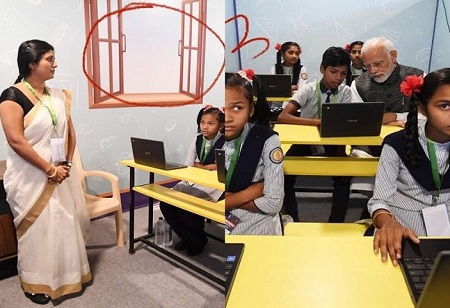The ancient Indian educational system focused on building a disciplined and value-based culture. Human values such as trust, respect, honesty, dignity, and courtesy are the building blocks of any free, advanced society. These values and authentic culture have given India the title of ‘Vishwaguru. But India has lost the title of ‘Vishwaguru’ due to prolonged struggle and a weakening of moral strength. India is weakened by losing its rich values and culture. Under a conspiracy, the British weakened the powerful ancient education system of India. By declaring our superior Vedic knowledge a myth and impractical, we disrupted the basic stream of education. During the freedom struggle, the freedom fighters understood this deeply, but the governments formed after independence did not pay attention to it and adopted the education system of the British, which, by erasing the ethical values and filling it with western thinking, has become fatal for the country.
As a protest against British education, Rabindranath Thakur, followed by Maharishi Arvind, Swami Vivekananda, Sister Nivedita, Swami Dayanand Saraswati, Lal-Bal-Pal, and Gandhiji, kept the flame of national education lit. At the same time, a holistic and coordinated campaign of ancient and modern education started in the form of Vidya Bharati, according to Hindu ideology. When non-Indian education continued to be given even in independent India, Vidya Bharati started the campaign for the education of Indian values in the field of education. In 1952, the first Saraswati Shishu Mandir of the Vidya Bharati scheme was started in Gorakhpur. Today, about 25,000 education centres of Vidya Bharati are running, in which education is being given from person to nation. The role of Vidya Bharati, the contributor to the education revolution, in building a new India and making the people’s consciousness all-round and strong is neither in words nor in any medium. This campaign of active education in nation-building is not only unique, wonderful, and miraculous but also vast.
The full name of Vidya Bharti is Vidya Bharti All India Institute of Education. This institute has lived up to its name. From Leh in the north, Rameswaram in the south, and Munabao along the border with Pakistan in the west to Haflong in the Northeast are the Vidya Mandirs of Vidya Bharati. From the prosperous colonies of big metropolises to the small settlements in Girikandara, the education centres of Vidya Bharati are engaged in this important task of nation-building. From an organisational point of view, Vidya Bharti has divided the whole country into eleven regions. There is a regional committee in each region, under whose direction the provincial committees look after the affairs of their respective provinces. Under these provincial committees, the district committee and school committee do direct work. All these eleven committees work under the guidance of the Central Committee. The head office of the Central Committee is in the capital of the country, Delhi. The total number of districts in the country is 711, out of which 632 are functional districts. Total formal schools are 12,830; total informal centres are 11,353; total educational units are 24,183; the number of students studying in the country is 34 lakh, 47 thousand, 856; and total teachers are 1.5 lakh. On the basis of these statistics, it can be said that Vidya Bharati is the largest educational institution not only in the country but also in the world at the non-government level. Despite being non-government, Vidya Bharati is also the most effective educational institution.

